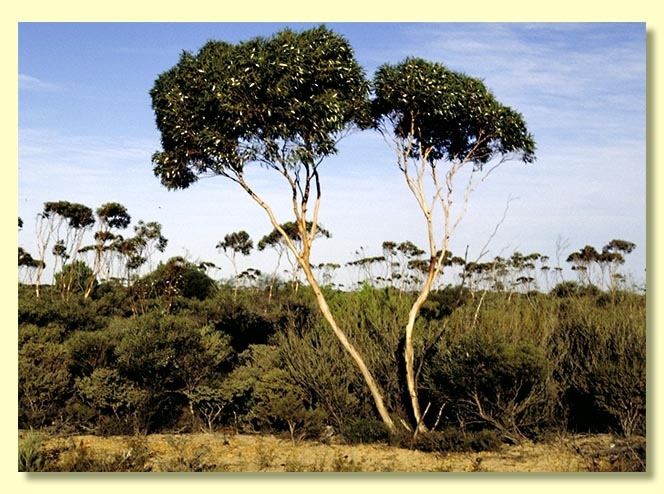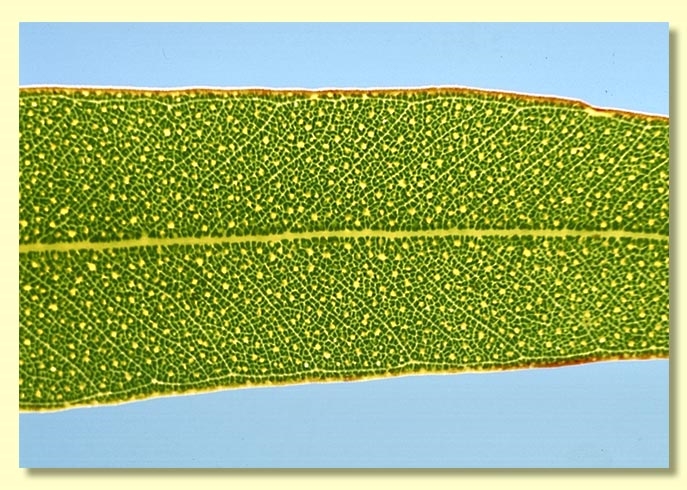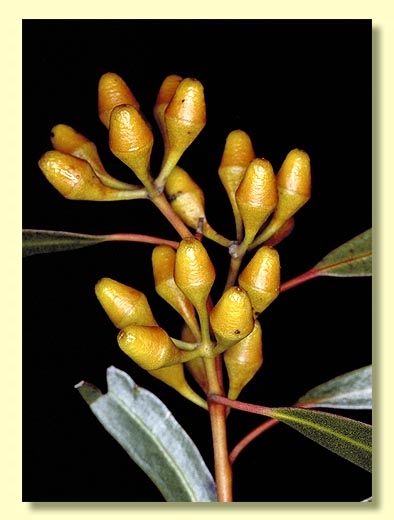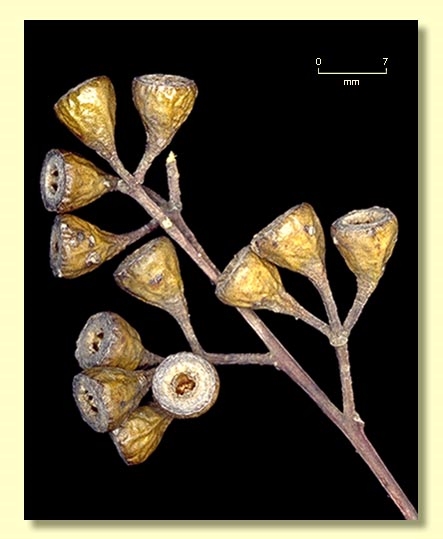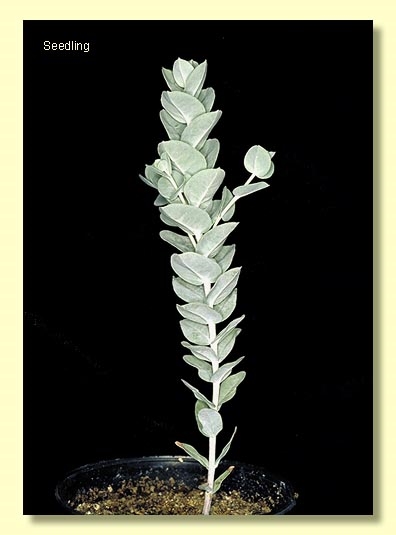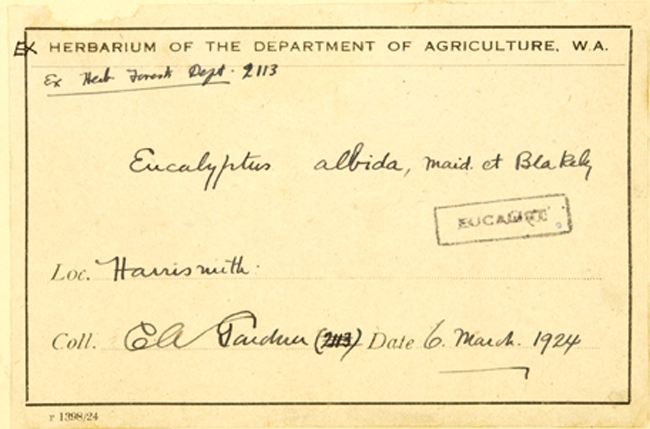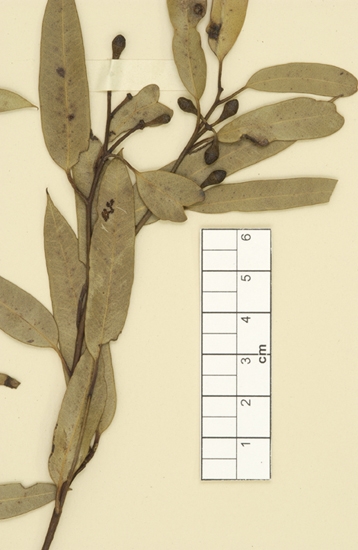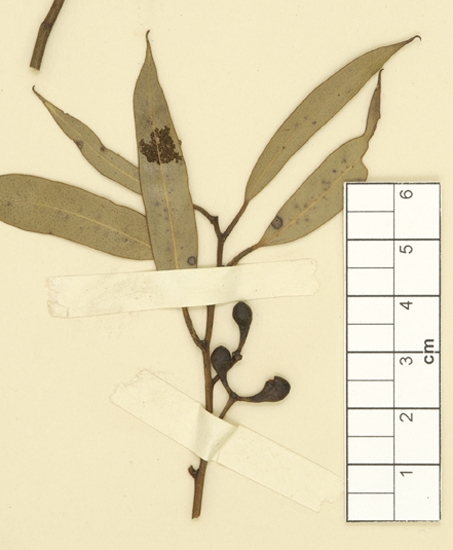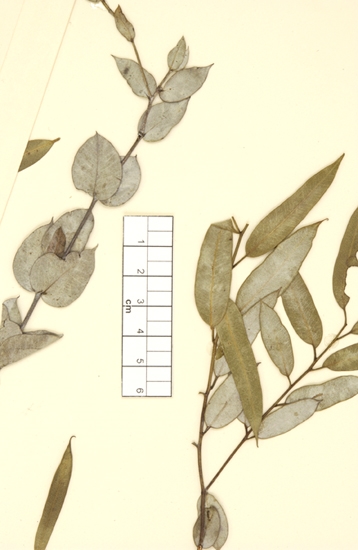Euclid - Online edition
Eucalyptus albida
Eucalyptus | Symphyomyrtus | Bisectae | Destitutae | Porantherae | Ovatae
Bark smooth throughout, often powdery, white to cream over grey.
Branchlets lacking oil glands in the pith.
Juvenile growth (coppice or field seedlings to 50 cm): stems rounded in cross-section, glaucous; juvenile leaves sessile, opposite for many nodes, orbicular to cordate, 1.5–4 cm long, 1.3–3.5 cm wide, base amplexicaul, apex rounded often with a small point, white with wax.
Adult leaves alternate, petioles 0.7–1.7 cm long; blade narrowly lanceolate to narrowly elliptical-oblong, (4)5–7.5(10.5) cm long, 0.5–1.7 cm wide, base tapering to petiole, margin entire, apex finely pointed, concolorous, very glossy, dark green, side-veins greater than 45° to midrib, reticulation dense, intramarginal vein close to margin, oil glands large, numerous, intersectional.
Inflorescence axillary unbranched, peduncles 0.5–1.5 cm long, buds 7 or 9 per umbel, pedicellate, pedicels 0.3–0.6 cm long. Mature buds bluntly ovoid to diamond-shaped (0.6–1 cm long, 0.5 cm wide), scar present, operculum conical to rounded but with a flattened apex (0.3–0.5 cm long), stamens usually inflexed or with a few irregularly placed, anthers cuneate-cuboid, adnate to filament apex (rigidly basifixed), dehiscing by sub-terminal pores, a few of the innermost stamens imperfectly formed, style long and conspicuously twisted apically, stigma tapered, locules 3(4), the placentae each with 4 vertical rows of ovules. Flowers creamy white.
Fruit pedicellate (pedicels 0.2–0.5 cm long), hemispherical to obconical, 0.5–0.6 cm long, 0.5–0.8 cm wide, disc descending, valves 3(4), held near rim level.
Seeds brown-grey, 1–2.5 mm long, flattened-ovoid, often pointed at one end, dorsal surface frequently longitudinally furrowed but surface smooth, hilum ventral.
Cultivated seedlings (measured at node 10): cotyledons Y-shaped (bisected); stems rounded to square in cross-section, glaucous; leaves sessile and opposite for at least 28 nodes, successive nodes closely spaced and leaves therefore overlapping, first pairs oblong then becoming cordate or orbicular, 1.3–3 cm long, 1–2.5 cm wide, base amplexicaul, apex rounded-apiculate or pointed, white-grey with copious wax.
Flowering has been recorded in January and December.
A smooth-barked mallee endemic to Western Australia, found principally in the southern wheatbelt from Tammin and Narrogin east to Hyden and Ravensthorpe but with a small occurrence in the northern sandplains near Badgingarra. It is an emergent mallee in heath on white sands. The transition from very conspicuous, sessile, orbicular to cordate, white, waxy juvenile growth to narrowly lanceolate glossy green adult foliage is quite abrupt. The buds have an obtusely conical operculum and the style (easily seen in the immature fruit) is always twisted at the top.
It belongs in Eucalyptus sub-genus Symphyomyrtus section Bisectae subsection Destitutae because the buds have two opercula, cotyledons are Y-shaped, and branchlets lack oil glands in the pith. Within this subsection E. albida belongs to a group of about 16 species, series Porantherae, that are further characterised by having anthers completely adnate to the staminal filaments, strongly inflexed stamens, densely reticulate leaves with intersectional oil glands, and by the fruit, which have a distinct thick rim that includes a whitish descending disc. The small, glossy leaves of species in series Porantherae may result in confusion with species in series Heterostemones; however, the fruit alone usually distinguish the series. The fruit of series Heterostemones are thin-rimmed.
E. albida has the glossiest leaves of the species in the series, the whitest juvenile leaves, and the twisted style character always occurs. Within its area of distribution it is most likely to be confused with E. dissimulata, which has similar blunt buds but elliptical grey-green (non-glaucous) juvenile leaves and a straight style. E. horistes, a related species found mainly in the northern and central wheatbelt but extending south to about Wagin and east to the goldfields, has beaked buds and glaucous orbicular slightly warty juvenile leaves and rarely has a twisted style.
Two other species with distribution overlapping that of E. albida are E. latens and E. uncinata. E. latens is distinguished from E. albida by elliptical-oblong bluish grey to glaucous juvenile leaves and Wandoo woodland habitat. E. uncinata has glaucous juvenile growth with the opposite leaves frequently connected around the stem (connate). Bothn species lack the prominently twisted style of E. albida.
The juvenile or coppice-growth of E. albida is used as decorative filler in dried floral arrangements because of the spectacular white round leaves.

